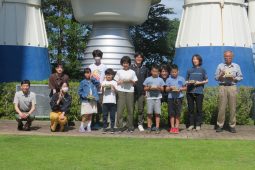PPARCセミナー(2024/2/9)

PPARCセミナー(2024/2/9)
[Name]
Hajime Ohata
[Title]Development of mid-IR heterodyne spectrometer with hollow fibers and the hollow fiber coupler for the observation of planetary atmospheres
[Abstract]Mid-infrared (IR) laser heterodyne spectroscopy is a method in which the light from the target source is mixed with the light source from a IR laser as a local oscillator (LO). Original frequency is converted into the intermediate frequency below several GHz, which is the frequency difference between the target and the LO. This method can achieve an ultra-high wavelength resolution of λ/dλ>1,000,000 (frequency resolution <30 MHz) in the mid-IR the wavelength of 10 μm (frequency of 30 THz). This enables to detect wind velocities in the planetary atmosphere directly with a resolution of several 10 m/s. Ultra-high resolution also has a capability to highly sensitive detections of trace gas and isotope ratios in the atmosphere. Notable successes on Venus, Mars, Titan, Jupiter, and Earth have been accomplished by ground-based telescopes with heterodyne spectrometers (e.g., Takami et al., 2020; Livengood et al., 2019; Kostiuk et al., 2001; Fast et al., 2002). However, these spectrometers require many optical elements to combine two optical paths, so their size and weight are large and their stability is not good. Because of this, the space-born heterodyne spectrometer has never achieved. Purpose of this study is to apply hollow optical fibers and its coupler to and to achieve the space-born system of the heterodyne spectrometer. Fiber optics enables the significant improvement to simplify, downsize, and reduce the weight of the equipment, leading to a breakthrough in space-born applications. We report the feasibility test results of a laser heterodyne spectrometer in the mid-IR region using fibers and a fiber coupler. (1) For the hollow fiber, transmission efficiencies of >85%/m were achieved for both CO2 lasers and quantum cascade lasers, and transmission efficiency of 89.6%/m was achieved for sunlight, which is incoherent natural light. It was also confirmed that heterodyne spectroscopy of lights from a black body and CO2 laser through fibers using a beam splitter can achieve the same sensitivity as that without fibers (Nakagawa et al. 2023). (2) For the hollow fiber coupler, we have demonstrated that heterodyne spectroscopy of CO2 lasers and quantum cascade lasers with a fiber coupler is as sensitive as the system with a beam splitter (Nakagawa et al. 2023). In addition, the heterodyne spectrometer using a CO2 laser as the LO showed system noise temperature was close to the quantum noise limit. System noise temperature was calculated by the Y-factor method, which uses the ratio of spectral power of black bodies that have two different temperatures 673 K and 293 K.
With these results, we have shown for the first time that it is possible to get spectra by the heterodyne spectrometer using fibers and a hollow fiber coupler. For the next step, we will try to observe a spectrum from the Sun through the atmosphere of the Earth and retrieve the amount of CO2 isotope. To observe it, we try to extend the observation bandwidth to 2.5 GHz by modifying the photodetector and FFT spectroscopy. Although these experiments were conducted in a laboratory, we will try to assemble a portable heterodyne spectrometer for attaching to a telescope. This system will be used for the test observations of the Martian atmosphere using the Hitomi telescope at Sendai Astronomical Observatory this summer. The observation targets CO2 absorption around 10μm and calculates the amount of CO2 isotope.





